Laser Diode Driver Basics and Circuit Design Fundamentals
Author: Stephen Gwinner Updated: August 5, 2024This TECH-NOTE is intended to give the reader an overview of laser diode driver design, how they function, and how to select the best laser diode driver for your application.

Introduction:
If you are about to begin working with laser diodes, you are most likely aware that their are some very specific nuances to safely biasing them and controlling their temperature. Laser diodes are highly susceptible to damage from forward and reverse voltage surges and transients, and they require a special set of specifically designed electronic control elements. This set of control elements are combined to produce what is commonly called a laser diode driver . Essentially, these elements determine how the laser is powered on and driven to produce a specific wavelength and output power. And how this is accomplished without damaging the laser diode. More »
QUICK NAVIGATION:
- BRIEF OVERVIEW OF LASER DIODES
- WHAT IS A LASER DIODE DRIVER?
- WHY YOU SHOULD NOT USE A BENCH-TOP VOLTAGE SOURCE
- WHAT ARE THE MAIN TYPES OF LASER DIODE DRIVERS?
- QUICK LOOK AT A LASER DRIVER CIRCUIT
- TYPES AND PRICES OF LASER DIODE DRIVERS
- WHAT IS THE MOST IMPORTANT FEATURE?
- WHAT IS THE MOST IMPORTANT SPECIFICATIONS WHEN CHOOSING A LASER DIODE DRIVER?
A Brief Overview of Laser Diodes:
In order to understand why laser diode drivers are important, it's important to understand a few of the key featues of laser diode devices. These devices require special attention to how they are turned on, operated and turned off. A laser diode is a semiconductor device made of two different materials. One a P-material, the other an N-material, sandwiched together. Forward electrical bias across the P-N junction causes the respective holes and electrons from opposite sides of the junction to combine giving off a photon in the process of each combination. The junction area’s surfaces (cavity) are to a mirror like finish. The electrical bias for the junction needs to be a stable, low-noise, transient free current source.
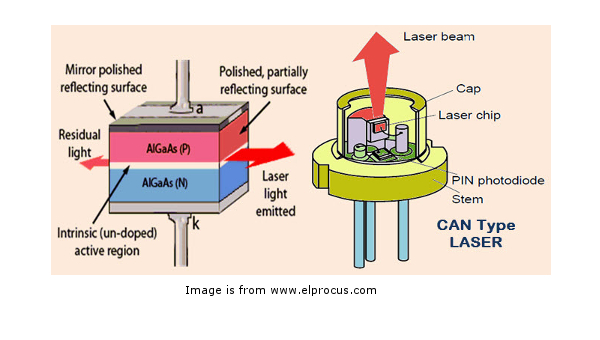
This short article provides basic information on laser diode drivers, and why they should be used to bias a laser diode instead of a standard DC supply. It provides a basic overview of how they work and the many types of drivers available.
What is a Laser Diode Driver? And What is a Constant Current Source?
A laser diode driver is a constant current source. Here is a helpful short video on YouTube explaining constant current and constant voltage sources, and why current sources are preferred for controlling laser diodes.
Understanding Tuning Coefficients and Efficiency:

Laser diodes are current driven and current sensitive semiconductors. A change in drive current equals a change in the devices’ wavelength and output power. Any instability in the drive current (noise, drift, induced transients), will affect the laser diode’s performance characteristics. Specifically, they will affect the output power and wavelength. Furthermore, the temperature of the diode junction is directly affected by current. Current instability will cause junction temperature swings; the output characteristics (again power and wavelength) will change. For the same diode referenced above:

Unstable drive current directly leads to junction temperature swings. Although the time scale is slower than the direct effect of current changes.
Understanding Dynamic Impedance and Your Driver's Forward Voltage:
The forward voltage across a laser diode is not constant. It changes, especially past the threshold point. The threshold point is the point at which the optical output power of the laser is linear with the input drive current, mW/mA.
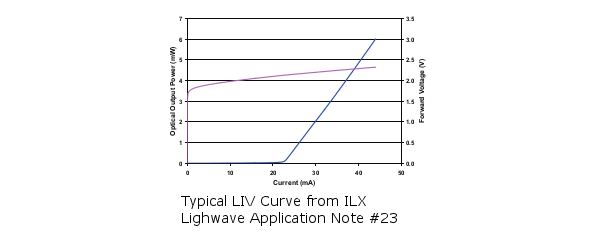
A first derivative of the V-I curve shows a plot of dynamic resistance of the diode, it also is not constant. So the entire load characteristic of a laser diode is not constant. Voltage and resistance change with current (and temperature). As shown in the video above on constant current sources, a stable current source will maintain a constant current regardless of the load connected to its output.
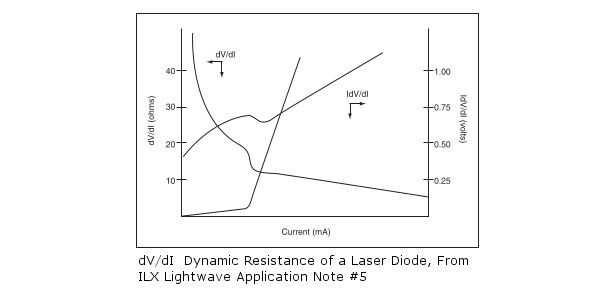
Why You Should Not Use a Bench-top DC Voltage Source:
Voltage sources (bench-top power supplies) ramp voltage at turn-on, but the current is not controlled. This is not good for diodes which require a precisely controlled current. A change in resistance on a constant voltage source results in a change in current. If the application demands constant laser output and stable wavelength, a voltage source will not work very well and may put the laser diode at risk from surges / transients due to quick changes in current. Thermal shock is also a risk factor to consider.
What are the Main Types of Laser Diode Drivers?
At a top level, there are a few classes or "types" of laser drivers which you will hear commonly discussed. These are: constant current (CW), pulsing (including QCW), low power and high power drivers. Constant current is just what it states, a constant output level over time. Pulsed laser diode drivers are an interesting variation in that the output is a function of time, duty cycle being the best way to describe it. Duty cycle is the time the current source is on - output current high divided by the total time of the pulse (on and off time). A quick note about off times in current sources, they are never truly off (meaning zero current), but often are at an output level low enough where the laser diode output is minimal - well below threshold.The next section loosely defines low and high power versions of these types of drivers.
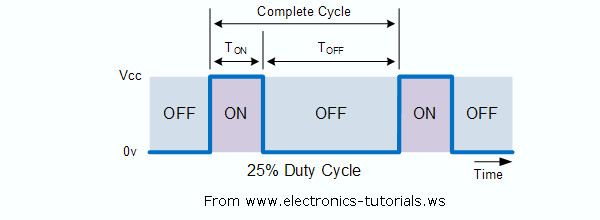
What are the Common Commercially Available Power Levels Available for Drivers?
"Low power" and "high power" drivers are common industry terminology that describes the magnitude of the output to the load. However, it’s a bit of a misnomer: the output level is not expressed in terms of power, that is Watts, it is expressed in terms of μA, mA, and amps. In the high power pulsed current source world, you may see the output pulse expressed in Joule’s, which is energy, ie 1W = 1J/s. The data sheets will usually also state output current magnitude and voltage, you just have to look for it. A low power driver is roughly defined as 1 mA to 5 Amps. A high power laser diode driver is 5 Amps and up to 100’s of Amps in a CW mode. Their are kW level drivers available in pulsed and QCW mode versions. These are by no means standards, just a generalization based on the author’s experience in the laser diode controller world.
Quick Look at a Laser Driver Circuit:
The next step is understanding from a schematic point of view how a “typical” laser diode current source works. Wavelength Electronics has an excellent video describing their current source designs. It is good information in block diagram form and easy to understand.
The information presented in this video will apply to most all commercially available laser diode current sources, differences in function and features will dictate the performance and surely price.
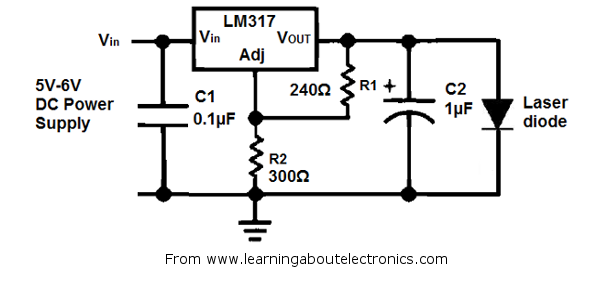
Of course you can go much, much deeper in your understanding of laser current sources. There’s a level where you may want to build your own, here you’ll need to understand electric circuits and components. A quick search of laser diode current sources on YouTube will result in a multitude of build your own current sources. For those of you with specialized requirements not met from commercial manufacturers, there’s a good paper titled An Ulta-high stability, low noise laser current driver from BYU. It is highly detailed, contains great schematics for those who understand electrical design with mathematically backed design principles and the performance backed up by data and graphs.
So, with that said, and the next level is to purchase a commercially available current source.
What are the Typical Price Ranges for Commercially Available Laser Diode Drivers?
Here is quick review of the basic package styles and price ranges of constant current and pulsed current sources which are commercially available.
» PCB Mount IC Level Current Sources: These are an integrated circuit (IC) which is soldered directly to a printed circuit board (PCB). These are typically lower power and basic current sources providing 10 mA – 500 mA. You will find these in your DVD player, bar code scanners, pointers etc. Price range: $10.00 to $100.00.
» OEM Module Drivers: These are current sources that are packaged in on onto a small housing or heat sink; connections to the driver module are required for the AC or DC power and the logic control supplies, plus connection to the load. They are available in a wide range of output current ranges, 50 mA – 100 Amps. Price range: $250.00 to $2500.00.
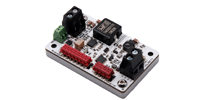
» Bench-Top Driver Instruments: These are stand-alone current sources that are housed in an enclosure with a front panel for easy control. The only connections to it are the AC input and the output to the laser diode load. These can be feature rich (microprocessor controlled, low noise, high stability, muti-range) or basic (analog control, single range, on/off), low power or high power. These are available in pulsed and CW modes from 100 mA to 100A or more. You will find these in many optical labs, clean rooms etc. Price range: $1,000.00 to $10,000.00
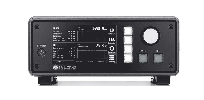
What is the Most Important Feature? Protecting Your Laser Diode:
As mentioned above, using a standard bench-top DC supply creates some risks of electrically damaging your laser diode. Strategies for protection found in most commercially available laser diode current sources include the way the current source is enabled and disabled (slow-start circuits), over-current and over-voltage protection (limits), and AC transient and wall plug power surge protection. Consideration of all protection levels should be a factor in not only commercial laser diode current sources, but also in the DIY lab or product development driver system.
What are the Most Important Specifications to Consider When Choosing a Driver?
This answer is most certainly dependent on the application for the diode. For example, a laser pointer doesn’t have as many stringent requirements on current control as a diode used in a spectroscopic application requiring a very narrow line width. In most research applications where you are intending to spend hundreds to several thousands of dollars on a laser diode current source, the most important spec's are: protection from current and voltage overshoots and transients, current noise density and long term stability. There are many other important features for sure, but you need a constant current source first and foremost to optimize and protect the laser diode for the particular application.

One more note about attributes, even though not mentioned in the top three, the current range is of course important. But beyond the obvious reason, here's why: If you purchase a current source with a 2 amp range and the diode requires only 50 mA, pay attention to the current source resolution, it is a function of the total output range. Output accuracy also scales with range if that is important in the application. Pay particular attention to the manufacturer's specifications for these spec's. Look for tech notes or ask the manufacturer how they are defined, measured and verified.
Who Makes Laser Diode Drivers?
Now you have a basis to help you start looking for a specific current source driver for your laboratory. You can visit our laser diode drivers index to compare price and specifications from many of the top manufacturers around the World. These companies offer a wide range of low power, high power, CW, and pulsed laser diode drivers rich in features and performance.
